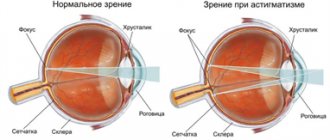What is color blindness?
Color blindness is a pathology of the visual system in which a person is unable to reliably distinguish colors. Most often, the anomaly occurs among males.
In this article
- What is color blindness?
- Features of the color perception process
- Myths and truth about color blindness
- Testing for color blindness: what is the Rabkin table?
- Why are drivers tested for color blindness?
- How is color blindness tested?
- Can color blindness be cured?
The disease occurs due to disorders associated with the pigments of the retina. It is often transmitted from mother to son in the womb (due to disturbances at the gene level, in the X chromosome). But there are many cases where, during a color blindness test, it turns out that the disease is not hereditary in nature, but is classified as acquired. This is possible with various types of injuries to the organs of vision, in which the integrity of the retina is disrupted, which subsequently disrupts the functions of the cones. For the first time, the chemist J. Dalton, who suffered from this disease, spoke about color blindness. In his works, the first records of color blindness were made in 1794.
Why can't people see colors?
In a person with normal vision, the retinal receptors contain sufficient amounts of pigments such as chlorolab, erythrolab and rhodopsin. In ophthalmology, this set is referred to as trichromate. If one or more pigments are defective or completely absent, color perception is impaired. As a result, one or another form of color blindness is diagnosed. The nature of the disease in children is determined by the transmission of an abnormal X chromosome, which is closely related to it. Colorblindness is almost always passed from mother to son (the woman acts as the carrier of the gene). In the case of the acquired form of the disease, the pathology usually occurs due to damage to the retina or optic nerve. The Rabkin table is the best method for identifying color vision disorders.
Features of the color perception process
Special pigments, such as chlorolab, erythrolab and rhodopsin, located in the receptors of the retina, are responsible for the normal perception of colors. Each of them is responsible for the perception of a certain spectrum - red, green, blue. In the absence of anomaly, the pigments are complete and contained in sufficient quantities. In this case, a person fully perceives the color palette. Those with correct color vision are called trichromats.
There are several forms of color blindness. For example, with anomalous trichromasia, all pigments are present, but are defective, which leads to unclear perception of shades. At the same time, a person distinguishes primary colors quite clearly. If any pigment is missing, dichromasia is diagnosed. In turn, it is divided into three subspecies. With tritanopia, a person perceives blue poorly, with deuteranopia - green, and with protanopia - red. Achromasia is considered the most complex type of color blindness. In this case, the surrounding world is perceived exclusively as black and white due to the lack of the ability to distinguish between all three color spectrums.
Thus, there are several types of color blindness. That is why a vision test for color blindness involves the use of different color images, as in the Rabkin table.
Checking color perception using Rabkin's tables online with answers
Rabkin tables for testing color perception are used to test color perception and identify the form and degree of its impairment. The set consists of 48 tables. Tables 1 to 27 are basic, tables 28 to 48 are control tables, for detailing the diagnosis and identifying cases of malingering and aggravation.
A vision test should be carried out according to the following rules: 1. The brightness of the computer screen should be average (a very dim or bright screen can interfere) 2. Rabkin tables should be at eye level and located perpendicular to the gaze (the inclination of the tables may affect the accuracy of diagnosis) 3. Time looking at the table for about 5 seconds (you should not look at the tables for a long time - this can give false results) 4. It is better to write down the answers on a piece of paper to compare them with the correct answers at the end of the article.
Types of color vision impairment and interpretation of the results at the end of the article. To test your vision for color blindness, the first 27 tables are enough; if you are interested in going through all of Rabkin’s tables, then the remaining 20 tables will be presented at the end.
Attention!!! You can check the answer for each table at once. To do this, hover your mouse over the table and you will see a tooltip with the answers.
N - normal trichromats, Pr - protanopes, De - deuteranopes, Pa - protanomalies, Yes - deuteranomalies, Pp - acquired pathology, + correct answer, - incorrect answer, II vertical rows are different, = - horizontal rows are different, A, B, C - strong, medium, weak degree of anomalies.
Normal vision in which there are three primary colors (green, red, blue) and their shades is called trichromasia. A person with normal vision is called a normal trichromat.
A condition in which three primary colors are distinguished, but shades are not distinguished, is called anomalous trichromasia . There are three types of anomalous trichromasia: protanomaly - impaired perception of shades of red, deuteranomaly - impaired perception of shades of green, tritanomaly - impaired perception of shades of blue.
According to the degree of violation, anomalous trichromasia is divided into A, B, C. Degree A is the most severe, grade C is the mildest. A person with anomalous trichromasia is called an anomalous trichromat or color anomalist . According to the colors: protanomal , deuteroanomal , tritanomal .
A visual impairment in which one primary color cannot be distinguished is called dichromasia . There are three types of dichromasia: protanopia - impaired perception of red, deuteranopia - impaired perception of green, tritanopia - impaired perception of blue. A person with dichromasia is called a dichromat . According to the colors: protanope, deuteranope , tritanope .
The complete inability to distinguish colors is called monochromasia . At the same time, a person sees everything in black and white colors and their shades.
Tritanomaly and tritanopia are extremely rare and are usually an acquired pathology. Other types of color vision disorders are congenital pathologies. Answers are given for normal trichromates (N), deuteronaps (D), protonaps (P)
Myths and truth about color blindness
Color blindness certainly affects a person's quality of life. For example, for potential drivers, this factor may become the main reason for refusal to issue a license when passing a mandatory medical commission. Moreover, patients who are unable to distinguish colors are somewhat limited in their choice of profession.
There are many rumors associated with color blindness. Let's figure out which of them are true and which belong to the category of myths:
- People suffering from color blindness see the world around them in black and white and cannot distinguish green from red. This definition of color blindness is not entirely reliable, since there are several types of pathology, and with some of them people cannot distinguish only certain shades related to certain colors.
- Color blindness is a purely male pathology. This statement is also wrong. Indeed, the majority of people affected by the disease are men, but many cases of color blindness have been recorded in women (mostly these are girls to whom the disease was inherited, that is, there were already precedents for color blindness in the family).
- It is impossible to develop color blindness as an adult. As already noted, the anomaly can be both congenital and acquired. It may be preceded by various retinal injuries.
It is also interesting that with a normal visual examination it is impossible to determine color blindness in a person - the pathology is not visually reflected in the eyes. Therefore, special diagnostic methods were invented, in which pathology is diagnosed using tables and cards. The most popular way to determine or refute this anomaly is considered to be Rabkin’s cards and tables.
What to do if the driver is found to have violations
There are two main types of color blindness: congenital and acquired. Congenital pathology of the retina, unfortunately, cannot be corrected at the moment. A way for colorblind people to see the world in the same way as other people is to wear specially designed contact lenses.
Scientists are also working on technology for introducing the corresponding genes into retinal cells.
Age-related color blindness is incurable. But sometimes when the lens is replaced, color perception returns to normal.
If color vision impairment was caused by damage from a chemical drug, there is a possibility of complete recovery when it is discontinued.
Loss of color vision is often caused by injury. In this case, the result of restoring the vision of colors depends on its severity. Sometimes a complete cure occurs and vision returns to normal.
In general, deviations from the norm in color perception do not in themselves pose a danger to human health. However, if this anomaly is detected in persons whose professional activity is related to color recognition, then it is necessary to take this issue seriously and find a more suitable type of activity.
Testing for color blindness: what is the Rabkin table?
There are 27 main and 20 additional polychromatic Rabkin tables. Cards belonging to the first type are used to identify color blindness, while cards belonging to the second type are used to clarify the diagnosis. The corresponding tables and cards can be seen in any ophthalmologist's office. The physician offers testing to all patients as part of a routine examination.
The tables allow you to quickly determine whether a person is color blind. For diagnosis, the subject is asked to examine, one by one, multi-colored pictures in which figures and numbers are “hidden.” During the test, no more than 5 seconds are allotted to review each map image. Depending on what numbers or figures the patient can see, the doctor determines his diagnosis (or lack thereof).
The Ishihara test is performed according to a similar principle, allowing one to determine the presence or absence of pathology. In addition, the FALANT test is used to diagnose color blindness. In this case, the patient is asked to determine the color of the beacon, which is located at some distance. All of these methods are very reliable and are actively used at present.
Color vision test for drivers
A medical examination of drivers is mandatory for everyone without exception. The law provides for the procedure and rules for its implementation.
An ophthalmologist's opinion is issued based on a vision test in the following areas:
With an understanding of the visual acuity testing process, as a rule, no questions arise. Regarding the point of checking for color perception, clarification and explanation, this will be necessary for drivers preparing to undergo an inspection.
A person's color perception is determined by heredity. In the central part of the retina of a healthy patient there are color-sensitive nerve receptors, the so-called cones. Each cone contains pigments of protein origin. There are only three such pigments.
The task of the specialist conducting the examination is to determine the norm or identify anomalies in color perception. Testing is carried out for these purposes.
Based on the test results, the following types of color vision are accurately identified:
- The normal type is trichromate. All three pigments (red, green and blue) are present.
- The anomalous type is dichromate. Only two of the three possible pigments are present.
- The abnormal type is achromat. Complete absence of color-sensitive pigments.
Why are drivers tested for color blindness?
Colorblindness in drivers is dangerous both for the person driving the car and for those around him. With complete color blindness, the ability to fully monitor the situation on the road is reduced. The driver, even with normal refraction, will have difficulty reading road signs, get confused by traffic lights, etc.
Therefore, checking for color blindness is a mandatory condition for a future driver to pass a medical examination, without which a license will not be issued in Russia. Thus, a person who is colorblind is legally prohibited from driving. But in real life, many people with this pathology continue to drive. Especially with a partial violation of color perception, which is not critical and does not interfere with control of the situation on the road.
How is color blindness tested?
The visual organs are tested for color sensitivity at an appointment with an ophthalmologist during a routine examination of the patient. You can also take the test using Rabkin’s tables and get an answer online. However, you should not completely trust the results of taking the test remotely, especially if potential signs of color vision anomalies are identified. The correctness of testing is influenced by many factors (lighting, monitor settings, etc.), so for specifics you will need to visit an ophthalmologist.
Main advantages:
- absolute testing accuracy;
- minimum wasted time;
- the result is known immediately after the test.
Rabkin tables are recognized throughout the world as the most effective methods for identifying color blindness. They occupy first place among all existing modern tests, as they reliably establish the form and degree of color perception.
You can purchase Rabkin’s tables with explanations in the online store. If you have any questions about our products, you can contact our customer service managers. We offer certified products at low prices. We have special terms of cooperation for organizations and medical institutions.
Can color blindness be cured?
Unlike acquired color blindness, congenital color blindness cannot be treated with medications or procedures. In the case when color blindness occurs as a result of injury, that is, it is classified as acquired, the situation is correctable. If the root cause of the color perception anomaly is stopped, then the number of pigments will most likely return to normal. This will allow a person to lead a full life.
With acquired color blindness due to age-related changes, it is not possible to restore the brightness of colors. However, the percentage of complete color blindness in patients due to age-related processes is minimal - contrast often decreases, while the person continues to distinguish colors, but may not clearly recognize some shades.










